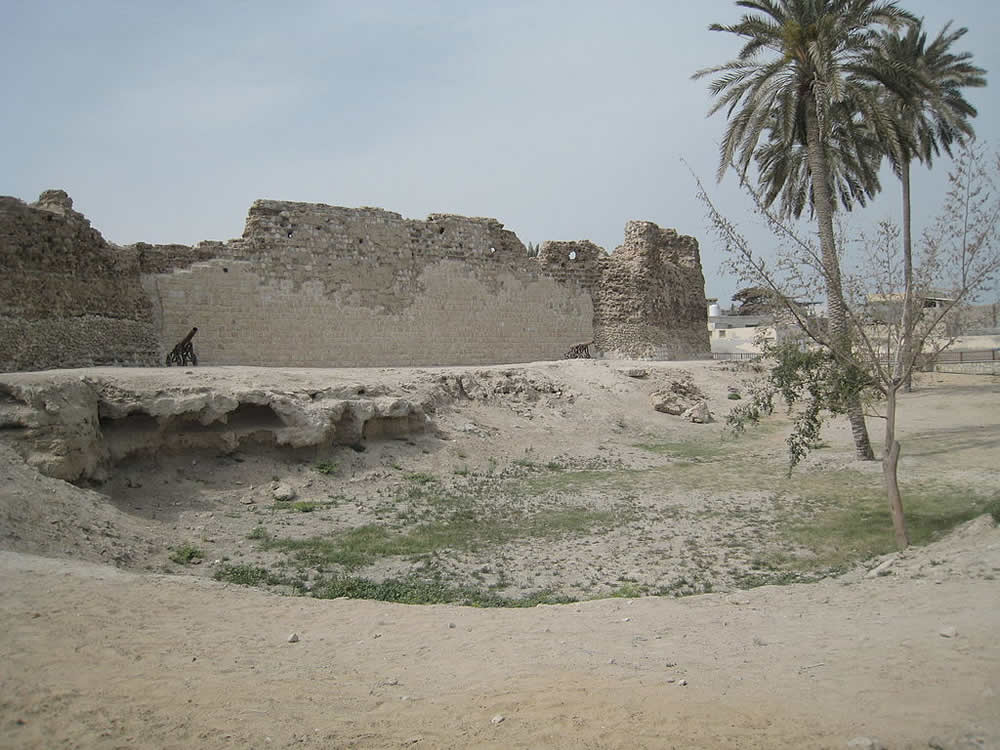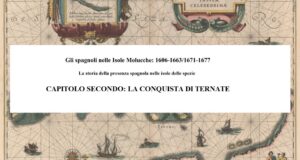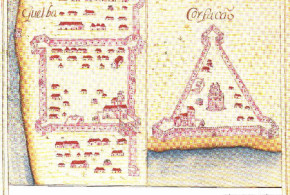Written by Marco Ramerini. English text revision by Dietrich Köster
The Portuguese decided shortly after their arrival in the Eastern Seas to prevent the Arabs’ trade by the conquest of Ormuz. For its strategical position, dominating the entrance to the Persian Gulf, Ormuz was one of the two strategical strongholds on the trade routes between the Arab world and Asia (the other being Aden near the Strait of Bab el Mandab). The city of Ormuz (Hormuz) was one of the most important trade centers of the whole East. On its market Persian horses and pearls were exchanged. The town was placed on a dry and barren island near the Persian mainland at the entrance of the Persian Gulf. For nearly 150 years Portugal ruled the Persian Gulf area. Ormuz was regarded by Albuquerque as the third key to the Portuguese Empire in Asia (the other two were Goa and Malacca).
The first attempt to conquer Ormuz was done in 1507 by Afonso de Albuquerque. He, at the head of a small Portuguese fleet of 7 ships and 500 men, proceeded to Ormuz. During the journey he stormed and conquered the towns of Kuryat, Muscat and Khor Fakkan. Differently the towns of Kalhat and Sohar expressed their willingness to become tributary to the King of Portugal. The Portuguese fleet anchored in front of the town of Ormuz. The King of the city was prepared for an attack and he could count on 15,000/20,000 armed men. Albuquerque was resolute and he asked the King to pay a tribute and become a vassal of Portugal, but the King’s reply was evasive, a simple attempt to protract the negotiations. After three days of waiting Albuquerque attacked the city and the King’s fleet was entirely destroyed. Seeing the complete defeat of his forces, the King sent a flag of truce offering to deliver up the city to the Portuguese.
In September 1507 Albuquerque concluded a treaty with the King of Hormuz, under which the King had to pay to the King of Portugal a yearly tribute. After this Albuquerque and his men began to build the fortress, the first stone was laid on 24 October 1507, the fort was named “Nossa Senhora da Victória”.
During the construction of the fortress insubordination arose among the Portuguese. Some Portuguese captains, with the help of the King of Ormuz, rebelled against Albuquerque. In January 1508, after several days of skirmish with the Ormuz’s forces, Albuquerque was forced to abandon the city. This was the first attempt to challenge the Portuguese rule in the Persian Gulf. The second attempt was made in 1515. In March 1515 Albuquerque with a force of 27 ships, 1,500 Portuguese and 700 Malabarese soldiers arrived in front of Ormuz. He was determined to take the town in the name of the King of Portugal and this time he was successful. The fortress was occupied by the Portuguese on 1 April 1515.
The fort was renamed “Nossa Senhora da Conceição”. When the Portuguese arrived, the main ports of the Persian Gulf and Arabia such as Julfar, Bahrain, Calayate (Qalhat), Mascate, Catifa (al Qatif), Corfação and the islands of Queixome and Lareca were all under the jurisdiction of the King of Hormuz. With the fall of Ormuz, all the cities and ports on the Persian Gulf became tributary to Portugal. The kings of Hormuz continued as a regional power in conjunction with the Portuguese. In this way the Portuguese rule began in the Persian Gulf, which lasted till the years 1620/1650.
In a document of the year 1515 (“Rendimento da cidade de Oromuz e seus reinos”) are reported the ports that paid tribute to Portugal. They were: Aigom and Docer “portos que estam na barra de terra firme”, Brahemim “porto que está de fora da ilha d’Oromuz na terra firme”, Tezer “lugar na terra firme”, Beabom, Borate, Jullfar (Julfar), Callayate (Qalhat), Horfacam (Khor Fakkan), Caçapo (Khasab), Broqete “na ilha Qeixa”, Lafete “na ilha Qeixa”, Qeixa “na ilha Qeixa”, Garpez “na ilha Qeixa”, Rodom, Costaque, Chagoa, Callecazei and Lebedia (Al-Bidyah).
“A cidade de Ormuz está situada em hua pequena ilha chamada Gerum que jaz quasi na garganta de estreito do mar Parseo tam perto da costa da terra de Persia que avera de hua a outra tres leguoas e dez da outra Arabia e terà em roda pouco mais de tres leguoas: toda muy esterele e a mayor parte hua mineira de sal e enxofre sem naturalmente ter hum ramo ou herva verde. A cidade em sy é muy magnifica em edificios, grossa em tracto por ser hua escala onde concorrem todalas mercadorias orientaes e occidentaes a ella, e as que vem da Persea, Armenia e Tartaria que lhe jazem ao norte: de maneira que nam tendo a ilha em sy cousa propria, per carreto tem todalas estimadas do mundo /…../ a cidade é tam viçosa e abastada, que dizem os moradores della que o mundo é hum anel e Ormuz hua pedra preciosa engastada nelle” Joao de Barros, Decada II, L. II cap. 2
In 1521 the King of Ormuz rebelled against the Portuguese, but the latter crushed the rebellion and put a new king on the throne. In 1523, Dom Luís de Menezes occupied Soar, which had revolted, and after this, he proceeded to Qeshm, where a new treaty was concluded with the new King and a feitoria was established. In 1526 Lopo Vaz de Sampayo, the Governor of Portuguese India (1526-1529), reduced to obedience Mascate and Khalat, which had revolted. In 1542/43 the entire Customs duties of Ormuz were assigned to the King of Portugal. The years between 1550 and 1560 were years of continued warfare with the Turks for the supremacy in the Persian Gulf. In 1550/51 the Portuguese conquered from the Turks the fort of El Katiff (Al Qatif) in Arabia. In 1551/52, in order to help Ormuz’s defence a fort was built in Mascate. The Turks were determined to take revenge and in 1551/52 they attacked Mascate and sacked the town. In 1559 the Turks besieged the Portuguese fort of Bahrein, but after several months of siege, they were forced to withdraw. In 1581, Mascate was again destroyed by the Turks. In 1582 the King of Lara (Larack, an island near Ormuz), who had revolted, laid siege to the fortress of Ormuz, but the Portuguese succeeded in driving away the invaders and they in turn besieged Lara’s fort of Xamel, which was taken by the Portuguese. Finally, in 1588 the Mascate’s fortresses were again rebuilt. This time the town was also fortified and in nearby Matara (Matrah) a fort was built, too. In 1602 Shah Abbas expelled the Portuguese from Bahrain.
Ormuz used for its provisions of water the wells of Comorão on the Persian coast. Here the Portuguese had a fort. It was conquered by the Persians in 1615 (1614?). In 1616 Soar, which had revolted, was captured by a Portuguese fleet and the King was put to death. In 1619 the Portuguese fortress of Ormuz had a garrison of 500-700 soldiers. The fort of Khawr Fakkan (Corfação) was built in 1620 by Gaspar Leite. On 8 May 1621 Rui Freire de Andrada, the “General do Mar de Ormuz e costa da Persia e Arabia”, began to build a fort in Queixome (Qeshm), this fort was built to have the control of the island’s water wells. The building of this fort was regarded as an act of open hostility by the Shah of Persia, who waged war against the Portuguese. In 1622, the Arabs, who had joined the Persians, succeeded in capturing Julfar from the Portuguese. On 11 February 1622, the Portuguese fort of Queixome, after a feeble resistance, was forced to surrender to a joint Persian-English army. On 20 Febraury 1622 the Persian flotilla of more than 3,000 men with the help of 6 English ships besieged the Portuguese fortress of Ormuz. Ormuz was lost by the Portuguese on 3 May 1622. The entire Portuguese population, about 2,000 persons, were sent to Mascate.
During the decade after the fall of Ormuz, the Portuguese, under the command of Rui Freire de Andrada, tried several times (1623, 1624, 1625, 1627) to regain the fortress. The last attempt in 1631 was a diplomatic one, but all these attempts failed. After the loss of Ormuz the Portuguese established their base in Mascate, and in 1623, a feitoria (trading station) was established also in Bassora at the mouth of the Euphrates River. In 1623 Rui Freire reoccupied the fort of Soar, which had been taken in 1622 by the Persians. In the same year a new base was established in Cassapo (Kashab) on the Musandam Peninsula. Kalba (Quelba) was conquered by Gaspar Leite in 1624. The fort of Mada was conquered in May 1624 by Mateus de Siebra. In 1624/25, following a treaty with the Persians, a feitoria and a fortress were established in Congo (Bandar-e Kong) on the Persian coast of the Persian Gulf. In 1631 a Portuguese fortress was built in Julfar, an important strategic point on the Musandam Peninsula. This town enjoyed during Portuguese rule great prosperity as the regional trading entrepôt. In September 1633 Rui Freire de Andrada, the great protagonist of these years, died and his body was buried in the church of St. Agostinho in Mascate. In 1633/35 peace treaties were concluded with the English and the Persians.
The Portuguese rule in the Persian Gulf was nearly more stable after the loss of Ormuz than before. In fact several fortresses and feitorias in a lot of places such as Soar, Julfar, Doba, Libedia, Mada, Khor Fakkan, Caçapo (Khasab), Congo (Kung) and Bassora were established. In August 1648, the Arabs besieged Mascate and on 31 October a treaty was signed between the two opponents. The terms were as follows: the Portuguese should raze to the ground the fortress of Kuriyat, Doba and Matara. In January 1650 Mascate, the last Portuguese base in Arabia, was taken by the Omanites. By the loss of Mascate the Portuguese were deprived of their last stronghold in the vicinity of the Persian Gulf and thus the so-called “Portuguese period” came to an end on the Persian Gulf.
- The Portuguese forts in the Persian Gulf and in Oman (1500-1650). Author Marco Ramerini
- Map of the Portuguese forts in the Straits of Hormuz. Author Marco Ramerini
- Map of the Portuguese forts in Oman. Author Marco Ramerini
- Jalali Fort, Muscat, Oman (photo © by Fritz Gosselck)
BIBLIOGRAPHY:
– Al-Khalifa, Shaikh Abdullah Bin Khalid and Abahussain, Dr. Ali “Bahrain Through The Ages – Vol.2” Historical Documents Centre, 1995, Bahrain
– Al Maamiry, Ahmed Hamoud “Omani – Portuguese history” 80 pp. ills. Lancers Publishers, 1982, New Delhi, India.
– Andrada, Ruy Freyre de “Commentaries of Ruy Freyre de Andrada” ? Edited with an Introduction by C.R. Boxer. 328 pp. Robert M. McBride & Co., 1930, NY, USA.
– Barendse, R. J. “The Arabian Seas, 1640-1700” vi + 465 pp. Leiden University, 1998, Leiden, NL.
– Boxer, Ch. R. “Anglo-Portuguese Rivalry in the Persian Gulf, 1615-1635” In: Boxer, Ch. R. “Portuguese conquest and commerce in Southern Asia 1500-1750” 1985, London, UK.
– Costa, Paolo M. “Historical interpretation of the territory of Muscat” In: Various Authors “Oman studies: papers on archeology and history of Oman” 203 pp. Istituto Italiano per il Medio e l’Estremo Oriente, 1989, Roma, Italia. pp. 97-117
– Costa, Paolo “Musandam: Architecture and Material Culture of a Little Known Region of Oman” ? 250 pp. Vine House, 1995,
– Dias Farinha, António “Os Portugueses no Golfo Pérsico 1507-1538 ” 266 pp. Dissertação Faculdade de Letras da Universidade de Lisboa 1990 Lisboa. Also in: Mare Liberum, Revista de História dos Mares Nº 3 , pp. 1-159, 1991, Lisbon, Portugal. This book contains a vast collection of documents about the first years of Portuguese presence in the Persian Gulf.
– Dinteman, Walter “Forts of Oman” 128 pp., numerous col. photogrs. 1993. A highly pictorial account of the role of the fort in Oman’s history since the 16th century.
– Gonçalves, Julio “Mascate, Albuquerque e os sultanatos do Omã 1507-1659” In: “Anais” do Clube Militar Naval, pp. 421-435 1940, Lisboa, Portugal.
– Kervran, Monik (ed.) “Bahrain in the XVIth Century. An Impregnable Island” 93 pp. ills., plans and maps Ministry of Information State of Bahrain, 1988, Bahrain. pp. 7-34
– Kervran, Monik; Negre, Arlette; Michele Pirazzoli “Excavation of Qal’at al -Bahrain 1st Part (1977-1979)” 119 pp, plans, b&w & col photos Ministry of Information, 1982, Bahrain.
– Kleiss, Wolfram “Die portugiesische Seefestung auf der Insel Hormuz am. Persischen Golf” Architectura, Munich 1978:8 166-183
– Muir, J. “Reminiscências Portuguesas na Arábia Oriental” 13 pp. Separatas do Boletim da Sociedade de Geografia de Lisboa 1961 Lisboa, Portugal.
– Ozbaran, Salih “The Ottoman Turks and the Portuguese in the Persian Gulf (1534-1581)” ? Thesis University of London, 1969, London, UK.
– Ozbaran, Salih “The Ottoman response to European Expansion. Studies on Ottoman-Portugese relations in the Indian Ocean and Ottoman administration in the Arab lands during the Sixteenth Century” xv, 222 pp. b/w ills., 4 maps, Analecta Isisiana XII, The Isis Press, 1994, Istanbul, Turkey. The complete collection of English articles written by Salih Özbaran from 1972 till 1993.
– Risso, Patricia “Oman and Muscat: an early modern history” ? xvii + 258 pp. Croom Helm, 1986, London, UK.
– Serjeant, R. B. “The Portuguese off the South Arabian Coast: Hadrami chronicles. With Yemeni and European accounts of Dutch pirates off Mocha in the seventeenth century” XIV, 233 pp. With 2 maps and 14 plates, 1974, Beirut, Lebanon. Clarendon, 1963, Oxford
– Slot, B. J. “The Arabs of the Gulf 1602-1784” ? xvii + 436 pp. Slot, 1993, Leidschendam.
– Vine, Peter; Casey and Vine, Paula (eds.) “Oman in history” 560 pp. Immel Publishing, 1995, London, UK.
– Ziolkowski, Michele “Al Bidyah excavations, 1999” In: “BSAI Nesletter” n°4, November 1999, British School of Archeology in Iraq.
 Colonial Voyage The website dedicated to the Colonial History
Colonial Voyage The website dedicated to the Colonial History










































































